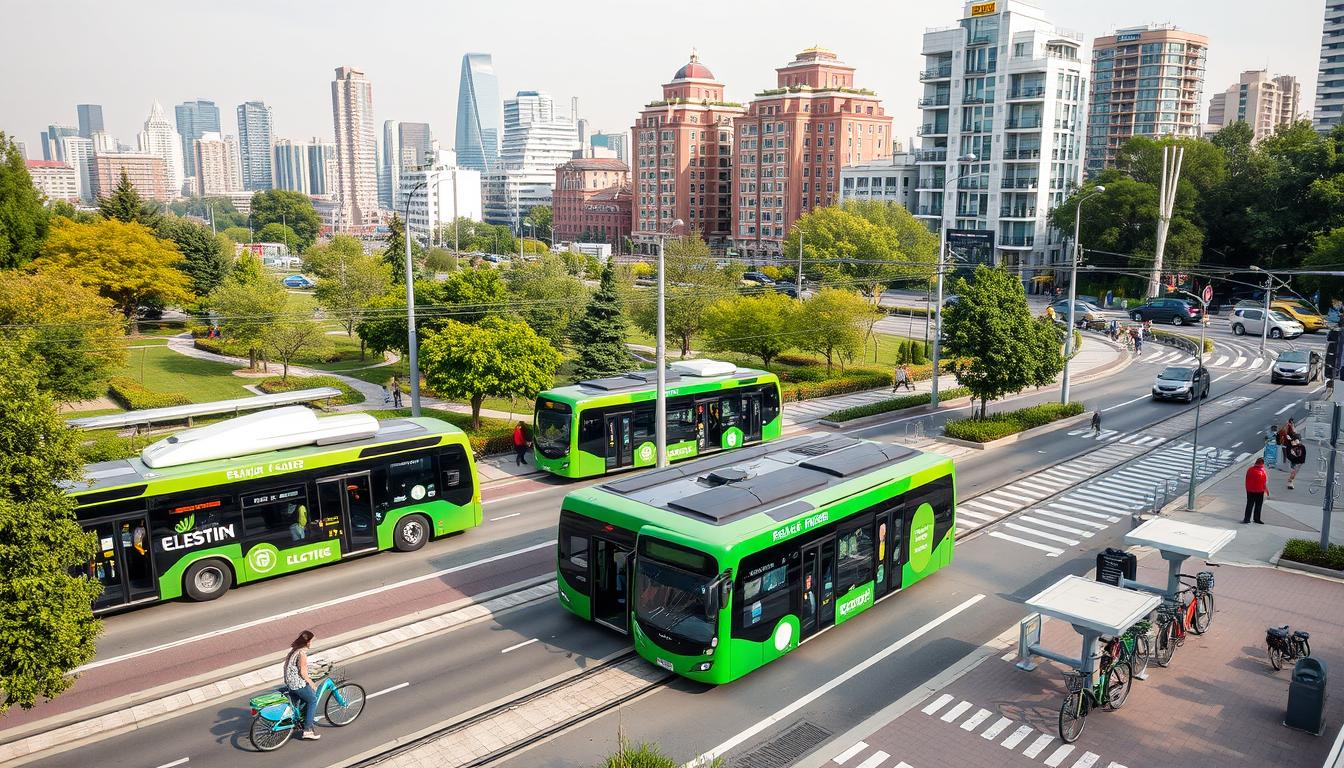Did you know that road transport generates approximately 28% of the United States’ annual greenhouse gas emissions? Our planet is facing significant environmental challenges. Changing how we travel is key to living sustainably.
This Green Transportation Guide is designed to help you discover eco-friendly travel options. These options can cut down your carbon footprint and save you money. In 2024, traveling green is not just a trend—it’s essential.
Transportation is changing fast. Electric cars, improved public transit, and innovative mobility solutions are transforming the way we travel. This Green Transportation Guide will provide you with 15 sustainable travel tips that are easy, affordable, and beneficial for the planet.
From electric bikes to smart carpooling, these options cater to various lifestyles. Whether you live in the city, suburbs, or travel long distances, this Green Transportation Guide proves there’s a green way to travel for you.
Let’s move towards a future where every trip helps our planet. With this Green Transportation Guide, we’ll do it one sustainable mile at a time.
Understanding Green Transportation: Current Trends and Statistics
Transportation is at a critical crossroads in our fight against climate change. The global transportation industry plays a big role in carbon emissions. Current data shows we face big environmental challenges that need new, green solutions.
Let’s look at key statistics that show we must cut down on transportation emissions:
- Global transportation industry emissions accounted for 15.9% of total emissions in 2016.
- Between 1990 and 2018, greenhouse gas emissions from transportation increased from 4.8 to 8.5 Gt CO2eq.
- Road transportation alone represents 73% of these emissions.
- Emissions are projected to double by 2050 if current trends continue.
Global Impact of Transportation Emissions
The environmental landscape is changing fast. Transportation contributes approximately 10% of total CO2 emissions in China, with similar trends worldwide. The carbon emission growth rate in the transportation sector has stabilized around 2% from 2010 to 2019. This shows a possible turning point in our approach to mobility.
The Rise of Sustainable Travel Movement
Innovative companies are leading the way to sustainable transportation. Tesla and Uber are at the forefront with electric and hybrid vehicle technologies. They show that green mobility can be both eco-friendly and cutting-edge.
Cost Benefits of Green Transportation
Choosing green transportation is not just good for the planet—it’s smart for business too. Research shows companies could lose up to $120 billion by 2026 due to environmental risks. By going green, businesses can cut emissions and lower financial risks. Transportation sustainability expert,
The future of transportation is green, efficient, and economically smart.
The Environmental Impact of Different Travel Methods
Understanding the carbon footprint of travel is key to eco-friendly transport. The transport sector is responsible for 16.2% of global greenhouse gas emissions. This makes our travel choices vital for the planet’s health.
Environmental Transportation Impact
Let’s look at the environmental effects of different travel modes:
- Road Vehicles: Constitute nearly 75% of transit-related CO2 emissions.
- Passenger Cars: Generate 60.7% of road transport emissions in Europe.
- Aviation: Produces only 1.9% of travel sector greenhouse gases.
Choosing low-carbon commuting options can greatly cut our carbon footprint. Trains are a top choice for sustainable travel, emitting 70-80% less greenhouse gases than cars and planes. Climate action expert said,
Every transportation choice we make is a vote for the kind of planet we want to live on.
Some interesting facts show how our travel choices matter:
- 85 million U.S. residents live in counties with harmful pollution levels.
- Air pollution causes approximately 7 million global deaths annually.
- 9 out of 10 people worldwide breathe air exceeding WHO pollution limits.
By picking sustainable transport, we can lower our carbon emissions. This helps make our planet healthier.
Electric Vehicles: The Future of Sustainable Transit
Green travel alternatives are changing how we move, with electric vehicles (EVs) at the forefront. The world of cars is moving towards cleaner, greener ways to travel.
Electric Vehicle Charging Station
The transportation sector is a big source of greenhouse gas emissions in the U.S., making up about 30%. Electric vehicles are a key solution to cut down on these emissions.
Types of Electric Vehicles
There are three main types of electric vehicles:
- Battery Electric Vehicles (powered solely by electricity).
- Plug-in Hybrid Vehicles (combining gasoline and electric power).
- Fuel Cell Vehicles (using hydrogen to generate electricity).
Charging Infrastructure and Accessibility
The Bipartisan Infrastructure Law has set aside $7.5 billion for EV charging.
Now, you can charge your car at:
- Home charging stations.
- Workplace charging locations.
- Public charging networks.
Cost Comparison with Traditional Vehicles:
| Vehicle Type | Annual Fuel Cost | Maintenance Cost | CO2 Emissions |
| Gasoline Vehicle | $1,500 | $800 | 4.6 Metric tons/year |
| Electric Vehicle | $500 | $300 | 1.15 Metric tons/year |
Experts say,
Electric vehicles can produce up to 75% less CO2 emissions compared to gasoline vehicles over their lifetime.
Battery costs have fallen by 89% from 2010 to 2020. This makes EVs more affordable. Drivers can save over $1,000 a year by choosing electric.
As technology gets better and more charging spots appear, electric vehicles are a great choice for those who care about the planet. They offer a clean, efficient way to travel.
Public Transportation: A Cornerstone of Green Transportation Guide
Public transportation is a key part of our green guide, helping cities move in a sustainable way. Cities are making their transit systems cleaner. This cuts down on carbon emissions and makes city life better.
Green Public Transportation Initiatives
The impact of public transit on the environment is huge. In cities, transport is responsible for about 29% of greenhouse gas emissions. Choosing electric or hybrid vehicles can cut emissions by almost half compared to gas cars. Urban mobility expert,
Public transit isn’t just a way to move—it’s a way to create a more sustainable future.
Key Benefits of Public Transportation
- Reduces individual carbon footprint.
- Decreases urban traffic congestion.
- Improves air quality.
- Supports economic development.
Innovative cities are at the forefront of green transit. For example, Los Angeles saw a 30% rise in Metro riders after getting federal funds. The bus rapid transit in Curitiba, Brazil, cut travel times by up to 50%.
Accessibility and Inclusivity
Today’s public transport focuses on being accessible. More than 50% have features for people with disabilities, like ramps and elevators. Studies show that making transit 1% more accessible can increase disabled people’s participation by 3%.
By using public transport, we’re doing more than just getting around. We’re making our world greener and more connected. Every trip we take helps lower our carbon footprint and supports cleaner cities.
Cycling and E-Bikes: Revolutionizing Urban Mobility
Urban transportation is changing fast, thanks to cycling and e-bikes. These green options are making city travel better for people and the planet. They offer a new way to get around that’s good for everyone.
E-Bikes Urban Mobility Revolution
Benefits of Electric Bikes
E-bikes are making a big splash in city travel. They now make up over 20% of all bike sales worldwide.
These bikes are great because they:
- Lower carbon emissions by up to 40%.
- Burn 300-600 calories per hour.
- Are an affordable way to travel.
- Help keep you fit and healthy.
Infrastructure and Safety Considerations
Cities in the U.S. are getting better at supporting e-bikes. Places like Portland, San Francisco, and New York City are adding more bike lanes and safety features. Riders should always wear helmets and follow traffic rules.
E-bikes are a big step forward for city travel. They’re good for your health and the planet.
Cost Analysis of Bike Ownership
It’s important to know how much e-bikes cost. Here’s a detailed look:
| Expense Category | E-Bike Costs | Car Costs |
| Initial Purchase | $600 – $8,000 | $25,000 – $45,000 (US dollars). |
| Annual Maintenance | $50 – $300 | $600 – $1,200 (US dollars). |
| Energy/Fuel Costs | $0.05 – $0.10 Per charge | $1,500 – $2,500 Annually. |
Choosing e-bikes can save you 60-80% compared to cars. With 790,000 e-bikes sold in the U.S. in 2022, and growth of 10.9% a year, they’re here to stay.
Carpooling and Ride-Sharing: Maximizing Vehicle Efficiency
Low-carbon commuting is changing city travel with new ride-sharing ideas. I’ll look into how carpooling cuts down on carbon emissions and saves money.
Carpooling Green Travel Alternatives
Transportation sustainability expert,
Sharing rides isn’t just about saving money—it’s about creating a sustainable transportation ecosystem.
Carpooling is a strong green travel option that changes how we see personal travel. It makes vehicles more efficient, lowering emissions and costs for each rider.
- Reduce personal carbon footprint.
- Share transportation expenses.
- Decrease urban traffic congestion.
- Create social connections during commutes.
The numbers show carpooling’s benefits. With only 1.7 passengers per vehicle, adding more can cut fuel use by 7.7%. Services like UberX Share offer up to 20% off, making eco-friendly travel affordable.
Ride-sharing platform, key features and cost savings chart:
| Ride-Sharing Platform | Key Features | Cost Savings |
| UberX Share | Up to 5 stops per trip | 20% Discount. |
| Lyft | 2 additional riders allowed | 15-18% Savings. |
| BlaBlaCar | International ride matching | Up to 50% cost reduction. |
By choosing carpooling, we’re not just saving money. We’re also making cities more sustainable and connected.
Walking and the 15-Minute City Concept
I’m excited to talk about how walking is changing how we move around cities. The 15-minute city idea is a big step towards making cities better for walking. It focuses on making cities easy to walk around in.
15-Minute City Walking Concept
Urban planners are making cities better for walking. They want walking to be a key part of our daily lives. About 12% of trips in the average U.S. city are already within a 15-minute walk from home. This shows how walking-friendly cities can be.
Health Benefits of Walking
Walking is great for our health, more than just getting from one place to another.
It can:
- Improve heart health.
- Lower stress and anxiety.
- Boost mental health.
- Help with weight management.
Urban Planning for Walkability
Cities like Portland and Cedar Rapids are making it easier to walk around. Portland wants 90% of its residents to be able to walk or bike for daily needs by 2030.
City, walking radius and carbon emission goal chart:
| City | Walking Radius | Carbon Emission Goal |
| Portland | 1-1.5 Miles | 90% Walkable by 2030. |
| Cedar Rapids | 1-1.5 Miles | 45% Reduction by 2030. |
Economic Advantages of Pedestrian-Friendly Cities
Urban design expert,
The 15-minute city transforms urban spaces from car-centric landscapes to human-centered communities.
Investing in walking paths and bike lanes creates jobs and saves money. The American Association of State Highway and Transportation Officials says bike and sidewalk projects create more jobs than car projects.
By making walking a main way to get around, we’re not just moving. We’re making our communities healthier, more connected, and better for the planet.
Train Travel: The Most Eco-Friendly Long-Distance Option
Train travel is a top choice for those who care about the planet. It’s a key part of the green transportation guide for long trips. Trains are a big step towards reducing our carbon footprint.
Here’s why trains are a standout choice:
- Produces up to 96.5% fewer CO2 emissions per passenger-kilometer compared to flying.
- Eurostar trains emit just 6g of CO2 per passenger kilometer.
- Often faster and more direct than aircraft on certain routes.
Experts say,
Train travel isn’t just transportation; it’s a sustainable journey through landscapes and environmental responsibility.
Let’s look at some stats on train efficiency:
| Transportation Mode | CO2 Emissions (G/Passenger-KM) |
| Eurostar Train | 6 |
| Domestic Rail Train | 41 |
| Private Car | 171 |
| Aviation | 255 |
Trains are not just good for the planet. They also offer a comfy ride, beautiful views, and a chance to get work done. As we look for ways to travel green, trains are a key part of the solution.
Sustainable Aviation: Reducing Air Travel Impact
Air travel is a big part of global emissions. Commercial flights make up about 3.5% of the Earth’s energy imbalance. But, the industry is working hard to make flying cleaner.
Alternative Fuel Technologies
Sustainable aviation fuel (SAF) is a big step towards cleaner skies. It can cut greenhouse gas emissions by up to 100% compared to regular jet fuel.
Some exciting developments include:
- Liquid hydrogen technologies for narrow-body aircraft.
- Hybrid aircraft designs with improved efficiency.
- Biofuel alternatives from sustainable sources.
Carbon Offset Programs
Airlines are starting carbon offset programs to lessen their impact. Sustainable Aviation Fuel certificates (SAFc) are a new way for companies to support green efforts. They don’t need to use SAF for every flight.
Future of Green Aviation
Climate innovation experts,
By 2050, we could see aviation transform into a significantly more sustainable industry.
The future of flying is looking up. By 2035, new tech could cut emissions from short flights a lot. Electric and hydrogen planes are coming, making air travel greener.
There are hurdles, but the aviation world is dedicated to cutting emissions. This drive for innovation could change flying in the next few decades.
Practical Tips for Greener Daily Commuting
Making your daily commute greener is easy. I’ve found simple ways to cut down on carbon emissions. These tips can make a big difference. Green transit network,
Small changes in daily transportation habits can create massive environmental benefits.
Using eco-friendly ways to travel can greatly reduce your carbon footprint.
Here are some easy tips:
- Optimize your driving efficiency by maintaining steady acceleration.
- Explore carpooling options to reduce individual vehicle emissions.
- Consider hybrid or electric vehicles for lower carbon output.
- Utilize public transportation whenever possible.
Driving smoothly is key to using less fuel. Edmunds.com found that smooth starts can save up to 31% on gas.
Commuting method, CO2 Emissions Reduction and Annual Cost Savings chart:
| Commuting Method | CO2 Emissions Reduction | Annual Cost Savings |
| Carpooling | 3-18% | Up to $1,100. |
| Public Transportation | 37 Million metric tons | Nearly $10,000. |
| Cycling | 67% | Thousands of dollars. |
Technology helps too. Apps and digital platforms offer route optimization, carbon tracking, and sustainable planning. They help you choose better travel options.
By using these green travel tips, you’ll help the planet and save money. Plus, you’ll get healthier too.
Conclusion
The future of how we move around is changing fast. More than 70% of people are choosing products that are good for the planet. They’re ready to make changes to help the environment.
Our look at different ways to travel shows us something important. Our choices can make a big difference. It’s all about making the right choices for our planet.
Going green is not just good for the earth; it’s also smart for our wallets. Electric cars, bike paths, and better public transit can cut emissions by 30%. Every decision we make can help make our air cleaner and our cities better.
We’re seeing big changes in how we travel. Electric cars are getting better, and cities are making places safer for bikes and walkers. This is a big shift towards a cleaner, healthier world.
This guide shows us that we can make our transportation systems greener. It doesn’t matter if it’s electric cars, buses, bikes, or just being more mindful on the road. Every little bit counts. Let’s all do our part to make the future greener.
Frequently Ask Questions (FAQ)
What is green transportation, and why is it important?
Green transportation means using travel methods that don’t harm the environment much. It aims to cut down on carbon emissions and energy use. This is key because cars and trucks release a lot of greenhouse gases. Using green ways to travel helps fight climate change, makes the air cleaner, and makes cities better places to live.
Are electric vehicles really better for the environment?
Electric vehicles (EVs) don’t release direct emissions, but their impact depends on the power source. Yet, they’re usually better than gas cars, as more power plants use clean energy. EVs cut down on air pollution and have less carbon emissions over their life compared to gas cars.
How can I make my daily commute more sustainable?
♦ There are many ways to make your daily trip greener:
- Use public transport.
- Cycle or walk when you can.
- Carpool or share rides.
- Work from home or use flexible work hours.
- If you must drive, choose an electric or hybrid car.
- Plan your route to travel fewer miles.
Are electric bikes a good alternative to cars?
Electric bikes (e-bikes) are a great choice for city travel.
♦ They offer many benefits:
- They’re low on emissions.
- They’re cheaper to use.
- They’re easier to pedal than regular bikes.
- You can go farther.
- They help reduce traffic and improve your health.
How expensive is it to switch to green transportation?
♦ The cost varies, but many green options can save you money:
- Public transit is cheaper than owning a car.
- Cycling and walking cost almost nothing.
- Electric cars have lower costs for maintenance and fuel.
- Carpooling cuts down on costs.
- Cities often give discounts for using green transport.
What are carbon offset programs for travel?
Carbon offset programs let you help reduce emissions by funding projects that do.
♦ These can include:
- Planting trees.
- Investing in clean energy.
- Capturing methane.
- Supporting green tech.
How can I reduce emissions when air travel is necessary?
♦ To lessen the impact of flying:
- Pick direct flights.
- Pack light to reduce weight.
- Choose airlines that care about the environment.
- Use carbon offset programs.
- Use other transport for short trips.
- Try to combine trips to travel less often.
What is the 15-Minute City concept?
The 15-Minute City idea is about making cities where you can get to work, shop, and more in 15 minutes by walking or biking. It aims to cut down on travel, make cities more walkable, and focus on community.
Are there government incentives for green transportation?
Yes, governments offer many incentives for green transport.
♦ Like These:
- Tax breaks for buying electric cars.
- Discounts for e-bikes.
- Subsidies for public transit.
- Support for car-sharing.
- Investing in bike and walking paths.
- Lower fees for green vehicles.
How significant is transportation’s impact on climate change?
Transportation is a big source of greenhouse gas emissions, making up about 29% of U.S. emissions. Switching to green transport is key to cutting down on carbon and fighting climate change.






















